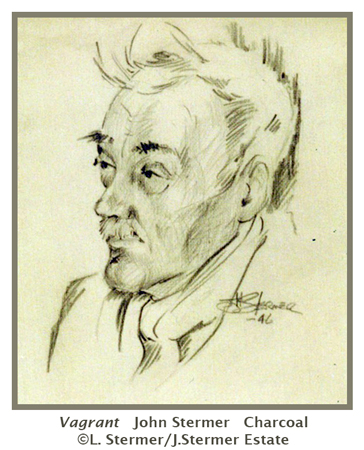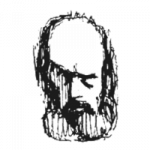Taking a drawing class reminds me of the time I took a drawing workshop from John Stermer (Dad). It was interesting to me that the basic structure of the class of the class was the same.
Drawing Class, Late 1970s.
Hi! This is John Stermer’s daughter Peggy at the keyboard. I’ve been remembering back to the days when I took a drawing class from my dad. As I recall, it was back in the late 70s and Dad was giving a drawing workshop. I was pleased that I was able to take his class.

Sarah F. Burns, Current Instructor.
But, before we get to0 far down memory lane, I would like to give you some context. I have just recently taken an anatomy class for artists from Sarah F. Burns of Project Space here in Oregon where I live. And, it was while drawing and studying the figure that I was brought back to my Dad’s workshop.
Classical Training.
I think it is worth noting that both my father, John Stermer, and artist Sarah F. Burns received a classical training in drawing and painting. Dad attended The Arts Students League of New York back in the 1940s and early 50s. The League provides atelier studio art training. Whereas Sarah received her training more recently and through multiple sources, she also attended an atelier here in Oregon. Atelier style training is based on a master artist working in a studio setting with a small number of students.
The point of all this about ateliers is to highlight that both my Dad, John Stermer, and my instructor, Sarah Burns, have had formal training in drawing. And, I find it interesting to seek similarities. Plus, it sets the stage for why Sarah’s class reminded my of Dad’s workshop.

Drawing Exercises.
What I remember of Dad’s workshop are some of the exercises. Yes, we did work from life, using a model. Sometimes the model was nude and, later, we used a “draped” model. To break the ice and get us warmed up, we worked through blind contour drawing exercises.
Blind Contour Drawings. I particularly like blind contour drawing exercises because they force me to look at the subject. And, I imagine my pencil touching the surface I’m drawing. In other words, you might say it is a tactile drawing exercise both physically and mentally.
Cross Contour Drawings. After a period of blind contour drawings, we spent time doing cross contour drawings. To clarify the difference between the two, with blind contour drawings, one’s focus is on the edges of the subject. Plus, you don’t look at our paper. On the other hand, with cross contour drawings, you are trying to mentally feel and draw across the form. So, you’re drawing what is between the edges. It is an interesting challenge.
Gesture Drawing. Now, we are still in the “warm up” phase of the workshop. Dad had us spending time on doing timed gesture drawings. That is, the model holds a pose for a short amount of time. It is an exercise that focuses the mind to see and feel the action, weight, and movement of the body. Plus, you certainly do not have time to think, just respond!
Long Pose.
Eventually, we would start to work on long pose drawings. And, they pose their own challenges and opportunities. With a long pose, you get to start to see the subject in a deeper, more deliberate way. Put it this way, you have all this time with the model. And, the more you draw, the more you see and learn.

Artistic Anatomy.
With Sarah’s workshop, which was focused particularly on artistic anatomy, she added a 90 minute lecture on the body. Most notably, we studied bones and muscles. This enables us to see the landmarks of the body as well as start to understand what all those muscles are doing. Then, in the afternoon, we worked on long pose drawings of the particular area.
Atelier Approach.
What I really liked about the atelier style approach to learning how to draw is the master and student relationship. It is scary facing your easel with a blank piece of paper and a pencil or piece of charcoal in your hand. You look at the model, then you look at your paper, and then, you a draw a blank. Literally and figuratively, the mind goes as blank as the paper. Fortunately, it only lasts a second or two and leaves as soon as you put the first mark on the paper.
The wonderful thing is having the master come around every now and to talk to you about your drawing. It really is a fine system for learning art.
Both Instructors Used Similar Approaches.
So, I might summarize that the similarities in approaches in both drawing classes seemed to bridge the gulf of 50 years between the two classes.

About the Drawings.
These are three drawing by the artist done at various points along his career. For more drawings by John Stermer, you may want to check out the article on scratchboard and ink. In any case, I hope you enjoy Dad’s drawings!

